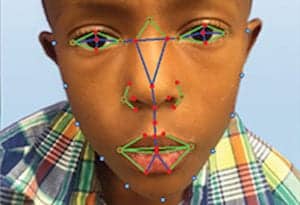Using innovative facial recognition technology, researchers have developed an easy way to accurately diagnose DiGeorge syndrome, a rare disease that can lead to heart complications and other health challenges.
With the facial recognition software, the researchers hope that doctors will soon be able to diagnose children with the disease by simply taking a photo and letting the technology do the rest.

While DiGeorge syndrome results in characteristic facial appearances in those it affects, doctors currently have a difficult time making a correct diagnosis because the condition can vary significantly from person to person. Some people may have a cleft palate or irregularly shaped ears, yet most health care providers “can’t pinpoint the disease,” note the researchers.
“Human malformation syndromes appear different in different parts of the world,” said Dr. Paul Kruszka, a medical geneticist in the Medical Genetics Branch of the National Human Genome Research Institute (NHGRI), which conducted the study. “Even experienced clinicians have difficulty diagnosing genetic syndromes in non-European populations.”
DiGeorge syndrome, also known as velocardiofacial syndrome or 22q11.2 deletion syndrome after the particular gene that’s affected in persons with the disease, affects about one in 3,000 to 6,000 children and generally affects only Africans, Asians and Latin Americans.
Related: New App Detects Early Signs of Autism in Children
The new software could be especially useful for DiGeorge syndrome because catching the condition early translates to improved outcomes and quality of life for those affected. DiGeorge syndrome is considered part of the Atlas of Human Malformation Syndromes, a project under NHGRI that tracks a variety of rare diseases affecting the population globally.
“Health care providers here in the United States as well as those in other countries with fewer resources will be able to use the atlas and the facial recognition software for early diagnoses,” said Dr. Maximilian Muenke, Chief of NHGRI’s Medical Genetics Branch. “Early diagnosis means early treatment along with the potential for reducing pain and suffering experienced by these children and their families.”
The Power of the Picture
The facial recognition software is similar to the security technology used in airports, and the researchers believe there is much untapped potential to put the software to use for health-related purposes.
For the current study, the team assessed 101 photographs of children with DiGeorge syndrome from 11 countries in Africa, Asia and Latin America. While the facial patterns varied significantly across the study participants, the software correctly diagnosed the syndrome 97 percent of the time.

The technology, developed by Dr. Marius George Linguraru with the Children’s National Health System in Washington, has already shown to accurately diagnose Down syndrome, according to researchers. Next, the team plans to study whether the software can also diagnose Williams syndrome and Noonan syndrome, two other rare diseases affecting children.
About 90 percent of patients with a diagnosis of DiGeorge syndrome have a “microdeletion” at a part of the genome known as 22q11.2, which in most cases occurs for unknown reasons and is not passed down genetically. However, once a diagnosis is made, “genetic counseling is critically important and testing should be offered to parents and other family members,” notes the Immune Deficiency Foundation.
The study appeared in the American Journal of Medical Genetics.
Related: Gene-Therapy Used to Cure Boy of Sickle Cell Disease
Richard Scott is a health care reporter focusing on health policy and public health. Richard keeps tabs on national health trends from his Philadelphia location and is an active member of the Association of Health Care Journalists.


![How To: ‘Fix’ Crepey Skin [Watch]](https://cdn.vitalupdates.com/wp-content/uploads/2017/05/bhmdad.png)












